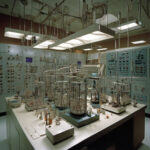A New Approach Allows Insertion and Real-Time Monitoring of Quantum Defects in Diamonds
A novel fabrication approach developed by collaborating scientists at some of the top universities in the world has paved the way for a groundbreaking method in quantum technology. This innovative technique enables the precise insertion and real-time monitoring of quantum defects in diamonds, unlocking a realm of possibilities for quantum computing, sensing, and communication.
Diamonds, known for their strength and brilliance, have also been recognized for their potential in quantum technologies due to the unique properties of certain defects within their structure. One such defect is the nitrogen-vacancy (NV) center, which consists of a nitrogen atom adjacent to a vacant site in the diamond lattice. NV centers have shown great promise in various quantum applications, such as quantum cryptography, nanoscale magnetometry, and even quantum teleportation.
However, the challenge has always been in precisely controlling the creation and monitoring of these quantum defects in diamonds. Traditional methods often lack the precision and scalability required for practical applications. This is where the new approach, developed through a collaboration of experts from leading research institutions, comes into play.
By utilizing a combination of advanced fabrication techniques, including ion implantation and high-resolution microscopy, the scientists have succeeded in precisely inserting individual nitrogen atoms into diamonds and creating stable NV centers with unprecedented control and efficiency. Moreover, they have developed a real-time monitoring system that allows them to observe and characterize the quantum defects as they form, providing valuable insights for further optimization.
The implications of this achievement are profound. Quantum computing, which relies on qubits to perform operations exponentially faster than classical computers, could greatly benefit from the stable and controllable NV centers in diamonds. These defects serve as robust qubits that can retain quantum information for extended periods, a crucial requirement for building reliable quantum computers.
In addition to quantum computing, the ability to manipulate quantum defects in diamonds opens up new possibilities in quantum sensing and communication. The high sensitivity of NV centers to magnetic and electric fields makes them ideal candidates for applications such as detecting tiny changes in brain activity or enabling secure quantum networks for communication.
As research in quantum technologies continues to advance, the development of this new approach marks a significant step forward in harnessing the potential of diamond-based quantum systems. With the ability to precisely insert and monitor quantum defects in diamonds, scientists are not only pushing the boundaries of what is possible in quantum technology but also paving the way for practical applications that could revolutionize industries ranging from cybersecurity to healthcare.
The future of quantum technology is shining bright, thanks to the innovative work of these collaborative scientists. By combining expertise from multiple disciplines and pushing the limits of fabrication techniques, they have unlocked a new era of possibilities for quantum computing, sensing, and communication. As we look ahead, it is clear that diamonds are not only a symbol of luxury and beauty but also a cornerstone of the quantum revolution.
diamonds, quantum technology, quantum computing, quantum sensing, quantum communication










